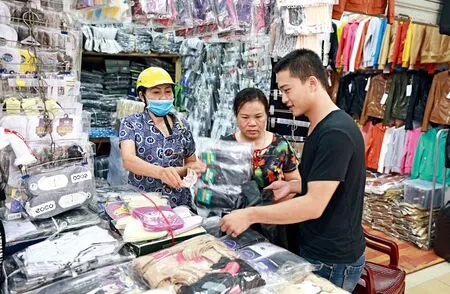JUST ACROSS THE RIVER
2018-01-13ByZhangChunxia
By Zhang Chunxia
Flourishing border trade helps boost China-Vietnam ties
It was not even nine o’clock yet on a September morning, but the bridge spanning the China-Vietnam border river Beilun was already bustling with car, truck and foot traffic. Fully-loaded trucks made their way slowly across the bridge, while numerous vendors and buyers, including many Vietnamese wearing green sun helmets or conical-shaped bamboo hats, are shuttled back and forth between Dongxing in South China’s Guangxi Zhuang Autonomous Region and Mong Cai, a border city in northern Vietnam.Dongxing, a county-level city administered by Fangchenggang City, is the only Chinese city that shares both land and sea borders with ASEAN. For Chinese and Vietnamese crossing the Dongxing border with frontier resident certificates, the border inspection procedure takes only five seconds. The convenient and efficient border crossing formalities, complemented by preferential trade policies and geographical advantages, foster the emergence of an increasing number of Chinese and ASEAN citizens working across borders between Dongxing and Mong Cai.
“Though my monthly salary stays at around 2,300 yuan(US$348), not much difference compared to my income in Vietnam,this factory provides free food and accommodation,which can help me save money. So, it’s pretty worthwhile.”


Ah Chau with a fellow Vietnamese worker.
Thousands of Vietnamese Workers in Dongxing
At the workshop of the Dongqi Incense Factory in Dongxing, several female workers were busy packing newly-made agarwood products. “The work here is easy, without much stress, and our boss is very nice,” said Ah Chau from Phu Tho Province of Vietnam, who could be easily mistaken as a local for her fluent Chinese. The 39-yearold began to learn Chinese in Hanoi more than a decade ago before heading to Taiwan for work.Therefore, she quickly adapted to the life and work environment here in Dongxing.
“My cousin introduced me to this job, and I’ve been working here for five months,” Ah Chau explained. “Though my monthly salary stays at around 2,300 yuan (US$348), not much difference compared to my income in Vietnam, this factory provides free food and accommodation, which can help me save money. So, it’s pretty worthwhile.” Her husband also works in Dongxing,earning 5,000 yuan (US$757) a month. The couple regularly sends money back home to their parents who look after their child in Vietnam.Ah Chau is just one of the several Vietnamese workers at the Dongqi Incense Factory.
“We currently have 11 Vietnamese employees and pay each of them less than 3,000 yuan (US$454) a month including salary, insurance and other benefits,which is much lower than the cost of hiring a local Dongxing resident,” said Zou Feng, director of the factory. “Furthermore, Vietnamese workers are more diligent and hardworking. For small start-ups like us, it’s very important that the cost of human resources can be controlled.”

Huang Xupeng speaks with customers in Vietnamese.
7million
The number of border crossings between Dongxing and Mong Cai reached 7 million in 2016,and this year that number is expected to top 9 million.
According to Zou, firms can only hire Vietnamese workers after obtaining employment qualification with the examination and approval of the local human resources and social security authority, and the employer must conduct unified management of the workers and ensure their safety. “To save our Vietnamese employees from visa application troubles, we provide them free work visas valid for a month, and to guarantee their safety, we provide transportation,” he explained.
To help Vietnamese workers feel at home in China, the factory encourages them to shop and cook for themselves, and grants them time off on Chinese legal holidays and traditional Vietnamese holidays alike.
In the past, Vietnamese working in China mostly engaged in sales and border trade. Along with the implementation of the Belt and Road Initiative, especially after July 2015 when the Dongxing National Key Development and Opening-up Experimental Zone launched the Sino-Vietnamese cross-border labor cooperation pilot program, which for the first time in history allows Vietnamese frontier residents holding legal and valid certificates to work at designated Chinese enterprises, an increasing number of Vietnamese laborers have crossed the border to seek a new life in China.
According to the Fangchenggang Municipal Human Resources and Social Security Bureau, as of Aug. 15, a total of 4,410 Vietnamese were working at 19 enterprises situated in the Dongxing Experimental Zone. “As local labor advantage gets more pronounced, some labor-intensive enterprises in East China have shifted their focus to the border region, which will bring benefits to the industrial development of both China and Vietnam, as well as the prosperity of border areas,” said Wei Juntuo,deputy director of the Fangchenggang Municipal Human Resources and Social Security Bureau.

23-year-old Huang Xupeng from South China’s Guangdong Province attempted to attract customers using his Vietnamese language skills.
Chinese Vendors in Mong Cai
Packages of varying sizes are piled up on both sides of the Beilun River. “These are all T-shirts and blouses to be sold in Mong Cai. I can earn about 30 yuan (US$4.50) each day by helping others transport the items,” explained a 70-year-old woman from Dongxing. With a frontier resident certificate, she can travel between Dongxing and Mong Cai many times every day, and her nephews also commute to work in the Vietnamese city on a daily basis. Dongxing’s border inspection station sees its busiest time of day in the early morning,when thousands of Chinese citizens walk across the border bridge to work in Mong Cai before returning home in the evening.
Entering a market in Mong Cai, we found that besides Vietnamese candies, food and daily necessities, there were a diversity of Chinese products including cloth, garments and kitchen utensils like basins and woks. A local guide told us that more than 70 percent of the commodities come from China, and that most of the Vietnamese vendors and shopkeepers can speak fl uent Chinese.If not for the signboards with Vietnamese text popping up before eyes now and then, the market could be easily mistaken for one in Dongxing.
At his own store in Mong Cai’s Central Market, 23-year-old Huang Xupeng from South China’s Guangdong Province attempted to attract customers using his Vietnamese language skills. “I followed my uncle to work here seven years ago, and three years ago I started my own business,” he said. “I arrive here around eight o’clock every morning and return to Dongxing in the afternoon. I acquired a temporary resident permit and business license in Dongxing, which makes it much easier for me to pass the border inspection every day.” Huang explained that compared to the high living expenses in his home city, low-cost living in Mong Cai allows him to save some money. To help grow his business, he taught himself Vietnamese, and when good luck knocks at the door, he said, he hopes to find a Vietnamese girlfriend.
There’re a great number of cross-border commuters like Huang. According to a staff member at Dongxing Port, the number of border crossings between Dongxing and Mong Cai reached 7 million in 2016, and this year that number is expected to top 9 million.
